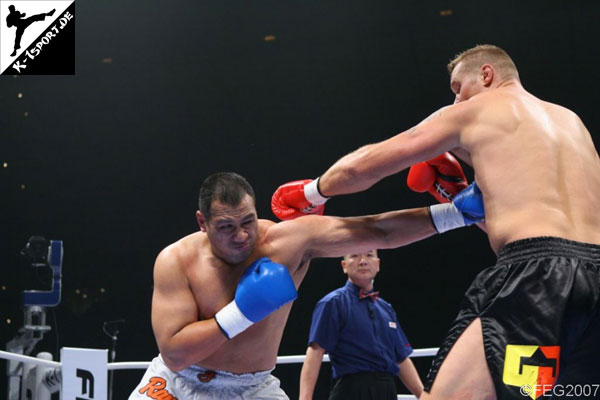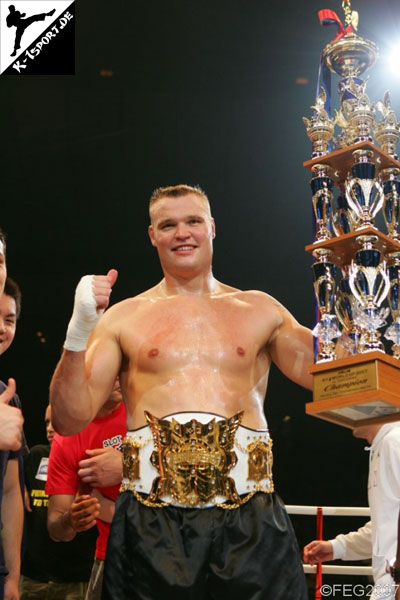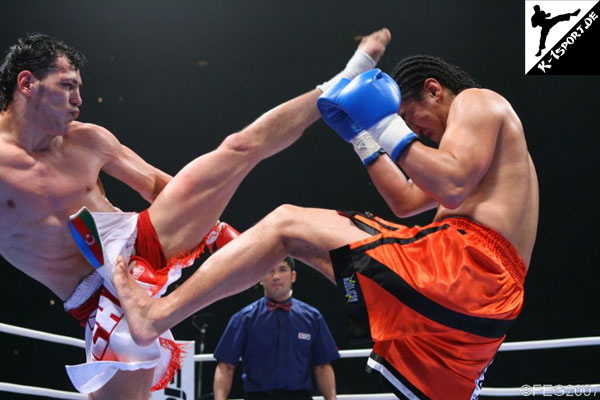Yokohama, March 4, 2007 -- Defending K-1 World Grand Prix Champion Semmy Schilt of Holland KO'd veteran slugger Ray Sefo of New Zealand tonight to become the first fighter to wear the new K-1 Super Heavyweight Title Belt. Schilt further distinguished himself as the first K-1 fighter to ever knock Sefo out.
With a star-studded card featuring established and up-and-coming fighters alike, the event kicked off K-1's 15th season with thrilling fights and a couple of dramatic upsets.

Opening Ceremony
The Fight Entertainment Group (FEG), which governs K-1, debuted two new weight classes here -- the Super Heavyweight division for fighters over 100kg/220lbs; and a corresponding Heavyweight class to accommodate fighters from 70kg/154lbs - 100kg, that is, between the existing World Max and new Super Heavyweight classes.
The Main Event saw Schilt and Sefo fighting for the Super Heavyweight Belt. The pair were fit and focused, and traded low kicks in the early going. Sefo overcame his 27cm/11" height disadvantage with excellent evasions and a tailored arsenal featuring low kicks, spinning back punches, and especially overhand punches and boomerang hooks. Schilt could not corral Sefo or get the knees up to effect, and as the first round progressed Sefo became more ambitious -- eliciting shrieks of approval from the young crowd when he dropped his guard to invite Schilt in. The crowd leapt to their feet when, at the bell, Sefo placed a left hook with enough authority to drop Schilt. On a night full of firsts, this was also the first time Schilt had been knocked down in a K-1 fight.

Ray Sefo vs. Semmy Schilt
When the bell sounded to start the second the atmosphere in the Yokohama Arena was electric. Schilt maneuvered his opponent into the corner, attempting to get the knees working, but Sefo squeezed out of trouble, calmly ducked a Schilt front kick and then went on the offensive, charging forward to throw a punch. Alas, Schilt was waiting with a punch of his own, a left straight which, ameliorated by Sefo's forward motion, packed more than enough kinetic energy to drop the Kiwi and earn Schilt both the KO win and the Belt.

Semmy Schilt, the Superheavyweight Champion
"I was fighting with a dislocated toe on my left foot, mentally I was okay, but I couldn't kick the way I wanted to," said Schilt afterward. "Ray had a good fight plan, to get close and punch -- but I'm not that easy!"
Also on the card were a pair of bouts to qualify fighters for the first K-1 Heavyweight Title Match, scheduled for Honolulu, Hawaii on April 28.
The first matchup, a tremendously exciting contest, pitted Moroccan bad boy Badr Hari against Russian dynamo Ruslan Karaev. This was a revenge bout, Hari having bitterly protested that a late hit from Karaev prematurely ended their fight at the Osaka Dome WGP Final Elimination last September.

Badr Hari vs. Ruslan Karaev
Here, Karaev came out like a loaded gun -- quickly closing the distance and pumping the fists, while Hari for his part countered the best he could with kicks. The first was fought full-speed, Karaev got a few through, but Hari also made good contact with a high kick. The second was wilder still, Karaev continuing with the fists, Hari throwing all manner of kicks. Karaev continued to press, and Hari would have jackknifed over the ropes midway through, had Karaev not reached over and pulled him back into the ring. As the intensity escalated, Karaev aggressively followed an uppercut with a left hook to score a down.
Hari beat the count, and after resumption arched gracefully to allow a Karaev left to sail past his face, then in an instant fired in a right straight punch -- a superb strike which made full contact and dropped Karaev to the canvas. There was no way the Russian was going to beat the count, the KO win leveling the score for these boys and sending Hari to Hawaii.
"I want to thank Ruslan," said Hari from the winner's circle, "because it takes two to make a fight. Now I want to say that in April, the K-1 Heavyweight Belt will be mine!"
Vying to represent Japan in Hawaii were veteran seidokaikan fighter Musashi and Yusuke Fujimoto, who won the Asia GP last year. The two were tentative in the first, testing with low kicks. Much of the same through the second, low kicks but precious little in the way of follow-ups, the crowd voicing their disapproval as the referee warned both fighters when they went to the clinch. Fujimoto had probably put slightly more stuff across overall, and brought the wider range of attacks through the third and to the final bell.
When the scores were announced, one judge liked Fujimoto, but the others saw a draw, prompting an extra round. Visibly riled, K-1 Rules Director Nobuaki Kakuda briefly stepped into the ring to implore the fighters to pick up the pace. Halfway through the tiebreaker, Fujimoto obliged -- hurling a high kick up to flatten Musashi. With the KO win Fujimoto earned himself a Hawaii Heavyweight Title date with Hari.

Yusuke Fujimoto vs. Musashi
"When Kakuda made his comment, it focused me on my fighting," said Fujimoto afterward. "I knew Musashi was hurting, and I picked the right moment for the high kick!"
The evening's action opened with a matchup between French kickboxer Cyril Abidi, making his first appearance in the K-1 ring in a year, and karate stylist Mitsugu Noda of Japan.

Mitsugu Noda vs. Cyril Abidi
Abidi got a left hook and a right front kick through in a less-than-technical first. For his part, Noda was warned some for holding, but also connected with a couple of strikes to keep things close. The Japanese fighter put a flurry of fists through early in the second to score a standing count, and Abidi listlessly rode the ropes for the remainder of the second. Head-to-head contact opened a gash over Noda's eye, but he was cleared to continue after a doctor's check. In the third and final round, after another doctor's check on Noda, Abidi finally managed a sustained attack. But it was too little too late, and judges gave this one to Noda by a comfortable unanimous decision.
Defending K-1 USA Champion Chalid "Die Faust" of Germany was a late scratch with the flu, and so his Golden Glory Gym training partner Gohkan Saki of Turkey laced them up against Japanese tough guy Hiromi Amada in the next fight.

Gokhan Saki vs. Hiromi Amada
Amada took a heaping helpful of Saki's low kicks in this one. By the second round the cumulative effect of these blows had Amada in trouble, unable to close with punches, wincing in pain. Amada was limping late in the round and turned away from his opponent, for which he was assessed a standing count. Seconds later, at the bell, Amada fell to the canvas, and his corner really had no other choice but to throw in the towel, giving Saki the win.
The card's third bout saw creative Russian kyokushin kicker Alexandre Pitchkounov step in against one of Japan's tallest fighter, 198cm/6'6" kickboxer Hiraku Hori. Pitchkounov looked the hungry fighter here, focused and always better with his attacks, evasions and blocking. Scarcely halfway thorough the first, the Russian just missed with a spinning back kick, but dexterously followed up with a straight left punch to score a down. Soon afterward, it was a couple of left hooks that earned Pitchkounov his second down. At the bell to end the first, Hori was once again on the mat, victim of yet another Pitchkounov left. Three downs in one round and it's game over boys -- an impressive win for Pitchkounov.

Alexander Pitchkounov vs. Hiraku Hori
Perennial Japanese hopeful Tsuyoshi Nakasako took on Alexey Ignashov's former sparring buddy Zabit Samedov of Belarus in a showdown between karate masters. Samedov's speed and footwork frequently got him inside, and he fought well there. A spectacular leaping punch attack ended the first round well for Samedov, who remained the more aggressive fighter through the second, clocking his opponent with a potent right hook. Nakasako did not make effective use of his reach, and in the third Samedov was again able to move effectively and penetrate at will. The Belorussian was especially good with counters to Nakasako's infrequent, sluggish kick attacks, dominating the fight and earning a majority decision.

Zabit Samedov vs. Tsuyoshi Nakasako
Popular French fighter Jerome Le Banner was one of the big draws here, accepting the challenge from Junichi Sawayashiki, a relatively unknown Japanese kickboxer a dozen years his junior and 20kg/45lbs leaner. LeBanner looked relaxed, patiently holding the center of the ring while Sawayashiki played the perimeter. And then it happened -- just as LeBanner stepped forward with a right, Sawayashiki countered with a lightning quick right of his own, dropping the Frenchman. The crowd gasped, then roared their approval. At the bell, LeBanner looked anything but pleased.

Junichi Sawayashiki vs. Jerome Le Banner
In the second again, Sawayashiki circled. LeBanner attempted to cut off the ring, but spent most of his time following and chasing his opponent in vain. Compounding his frustration, when LeBanner did close he was unable to get past his opponent's guard, and saw his right effectively countered. It was one such counter from Sawayashiki -- a hard tight hook late in the third, that cocked LeBanner's head violently to the left, sending his mouthpiece flying and his hopes tumbling. This second down secured a unanimous decision upset win for the 22 year-old Sawayashiki.
Highly-anticipated was the bout between gargantuan Korean Hong Man Choi and American slugger Mighty Mo. This was an exhilarating battle of size versus power, a display destined to top highlight reels for a good long time. Dealing with no less than a 33cm/13" height disadvantage, Mo was determined to get his fists up and onto Choi's noggin by whatever means possible. The American leapt, spun, flew and flailed, and, to the crowd's delight -- finally got results, landing an overhand right late in the first round.

Mighty Mo vs. Hong-Man Choi
In the second Choi seemed unsure how to bring his size into play, and even as he gazed down on his opponent, in the manner of a bear pondering how to dispatch a pestering hedgehog, Mo did it. And by gosh, he did it good! The Samoan first reached up with his left, coolly lowering Choi's leading arm, then suddenly pumped a hearty right up and over and smack onto the Korean's big jaw. Choi crumpled to the canvas, and he stayed there. A long time.
This was a herculean effort and an epic upset. When Choi finally found his feet, the first thing he did -- humbled some but nonetheless wearing a wide smile -- was warmly congratulate his scrappy opponent.
"He's a big guy, and he seemed to take forever to go down," laughed Mo in his post-bout interview. "I'm not afraid of any fighter, big or small, they all have their weak points, they all go down. The message I have is that Mo is back, and going up!"

All Fighters
The K-1 World Grand Prix 2007 in Yokohama attracted a crowd of 9,650 to the Yokohama Arena and was broadcast live across Japan on the Fuji TV network. For television scheduling information in other regions contact local broadcasters.
For official results, fighters' information, and coverage of this and all K-1 events, (including a complete archive of past events), visit the K-1 Official Website (http://www.k-1.co.jp/k-1gp/).


